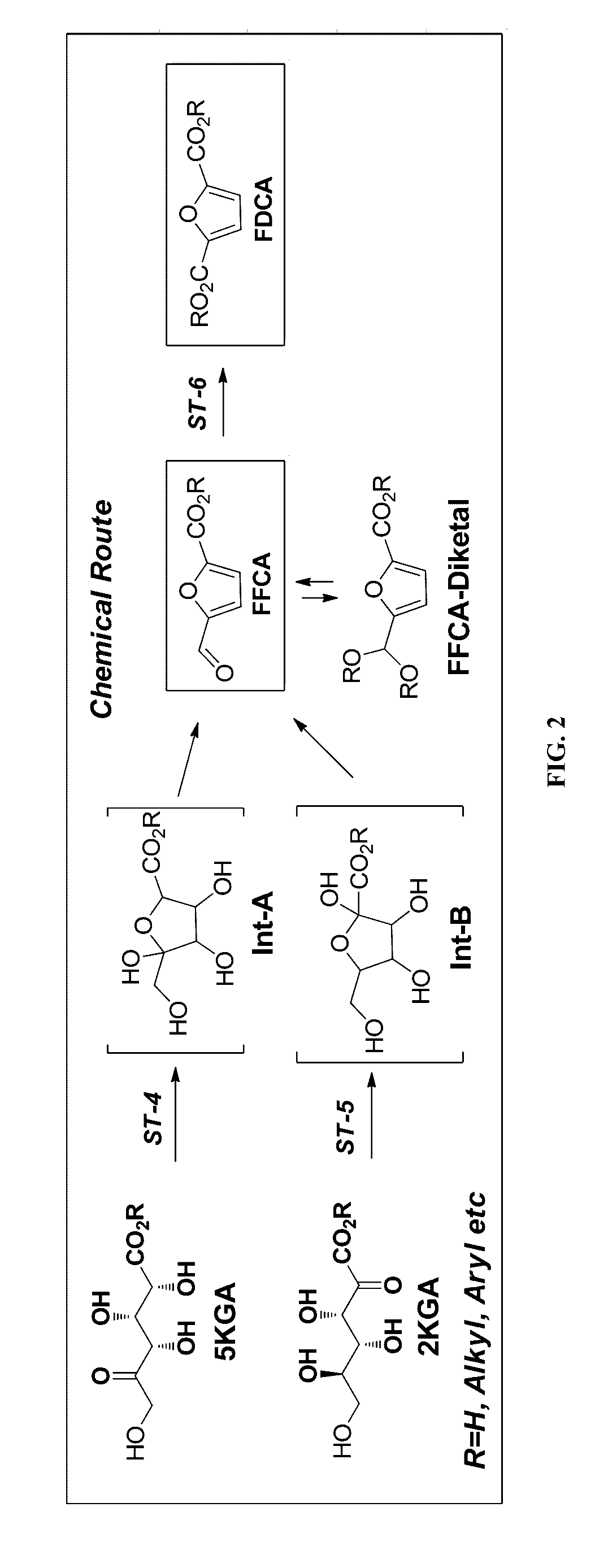Synthesis of FDCA and FDCA precursors from gluconic acid derivatives
a technology of gluconic acid and precursors, which is applied in the field of synthesis of fdca and fdca precursors from derivatives of gluconic acid, can solve the problems of reducing the yield of hmf, challenging the optimization of fructose dehydration, and not having efficient conversion methods availabl
- Summary
- Abstract
- Description
- Claims
- Application Information
AI Technical Summary
Benefits of technology
Problems solved by technology
Method used
Image
Examples
example 1
Dehydration of DHG in Aqueous Media in Batch Reactions
[0070]In each of three vials containing 4 ml of water 50 mg of DHG (70 mM) was dissolved. The following acids were then added: 1) 0.5 ml of concentrated H2SO4; 2) 130 mg DOWEX® 50x8 (H form) or 3) 130 mg AMBERLYST® 15 (H form). All reactions were incubated at 75° C. with good stirring. Reaction progress was analyzed by both TLC and HPLC using commercial 2-hydroxymethl-5-furan (HFCA) carboxylic acid as an authentic standard. Synthesis of HFCA was observed in all reactions reaching a yield of 5-10% after overnight reaction. The HFCA produced from these reactions was analyzed by MS spectra and was found to have the same retention time as the authentic standard. These results show that HFCA was produced from DHG when the DHG was subjected to a dehydration reaction through an acid catalyst.
[0071]In a separate experiment, 5 mL of an ethanol / water mixture (v / v, 9 / 1) containing 1.5 M of H2SO4 and 200 mM of purified DHG was placed in two ...
example 2
Dehydration of DHG and 2KGA in Flow Reactors
[0072]In this example reactions were performed under flow conditions using a flow reactor system (i.e. as continuous flow reactions). A stock solution of DHG was prepared by dissolving DHG in AcOH / H2O (v / v, 80 / 20) containing 1.5 M of HBr, to a final concentration of 200 mM. This solution was kept at ambient temperature (about 20° C.) and was passed through the reactor that was heated at either 100° C. or 120° C., at a pressure of 30 psi to keep solvents from evaporating. The reactor consisted of a glass column packed with 3 mL of sand. The flow rate was 0.05 mL / min, thus allowing a residence time in the column of about 40 min. Analysis of various samples at each temperature revealed that the reaction at 120° C. gave 50-70% yield of HFCA while the reaction at 100° C. produced 25-30% yield to product in addition to unreacted DHG (15%).
[0073]The same experiment was also performed using 2KGA as substrate, except that the reactor temperature th...
example 3
Dehydration of 2KGA and 5KGA in Aqueous Media in Batch Reactions
[0074]A number of different reactions were prepared according to Table 1 with 2KGA (200 mM) and 5KGA (200 mM) according to the conditions indicated. The reactions were incubated at 120° C. for 30 min before a sample was taken and analyzed by HPLC / MS. The formation of FFCA was confirmed and quantified by comparison with authentic material, and the amount produced, along with the conversion to products, is shown in Table 1.
TABLE 12KGA5KGA%%%%SolventAcid (mL added)[Acid]ConversionFFCAConversionFFCAAcOH (3.5 mL) H2O (0.5 mL)H2SO4 (0.3 mL)1M983.5991.1AcOH (3 mL) H2O (0.5 mL)H2SO4 (1.4 mL)5M1006.71000.0AcOH (3.5 mL) / H2O (0.5 mL)AMBERLYST ® (50 mg)910.3931.0AcOH (3.5 mL) / H2O (0.5 mL)DOWEX ® 50x8-H+ (50 mg)890.3980.0AcOH (3.2 mL) H2O (0.3 mL)Perchloric acid (0.8 mL)2M993.8990.5AcOH (4 mL)HBr (1.1 mL)2M1000.61000.2AcOH (4.0 mL) H2O (0.2 mL)HCl (0.8 mL), NaBr (100 mg)2M,1003.01001.50.2MAcOH (4.0 mL) H2O (0.3 mL)H3PO4 (0.7 mL),2M,...
PUM
 Login to View More
Login to View More Abstract
Description
Claims
Application Information
 Login to View More
Login to View More - R&D
- Intellectual Property
- Life Sciences
- Materials
- Tech Scout
- Unparalleled Data Quality
- Higher Quality Content
- 60% Fewer Hallucinations
Browse by: Latest US Patents, China's latest patents, Technical Efficacy Thesaurus, Application Domain, Technology Topic, Popular Technical Reports.
© 2025 PatSnap. All rights reserved.Legal|Privacy policy|Modern Slavery Act Transparency Statement|Sitemap|About US| Contact US: help@patsnap.com



